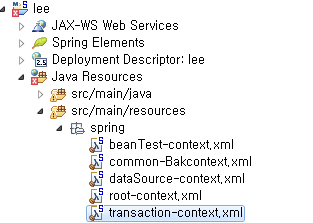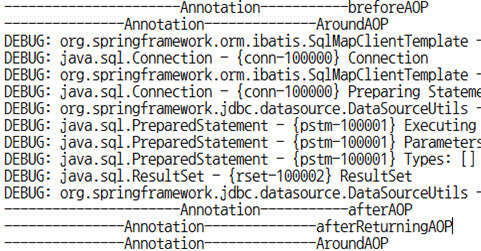먼저 스프링에서 AOP를 구현하는 방법은 3가지 입니다.
1. xml을 이용한 방법
2. Annotaion을 이용한 방법
3. AOP API를 이용하는 방법(요즘 이용도가 떨어짐)
저는 xml을 이용한 방법과 Annotation을 이용한 방법을 포스팅 해보겠습니다.
web.xml 설정
ApplicationContext 빈 설정
1 2 3 4 | <context-param> <param-name>contextConfigLocation</param-name> <!--빈 설정 파일들간에 구분은 줄바꿈(\n),컴마(,),세미콜론(;)등으로 한다.--> <param-value>classpath*:spring/*-context.xml</param-value> </context-param> |
그리고 transaction-context.xml 파일을 생성하였습니다.

라이브러리 설정
그리고 라이브러리들을 사용하기위해 aop, context, tx를 선언하였습니다. tx는 트랜잭션을 이용하기위해 선언하였으므로 굳이 안적으셔도 됩니다!
1 2 | <!--?XML:NAMESPACE PREFIX = "[default] http://www.springframework.org/schema/beans" NS = "http://www.springframework.org/schema/beans" /--><beans xmlns="http://www.springframework.org/schema/beans" xmlns:xsi="http://www.w3.org/2001/XMLSchema-instance" xmlns:aop="http://www.springframework.org/schema/aop" xmlns:context="http://www.springframework.org/schema/context" xmlns:tx="http://www.springframework.org/schema/tx" xsi:schemalocation="http://www.springframework.org/schema/beans http://www.springframework.org/schema/beans/spring-beans-3.0.xsd
http://www.springframework.org/schema/tx http://www.springframework.org/schema/tx/spring-tx-3.0.xsd
http://www.springframework.org/schema/context http://www.springframework.org/schema/context/spring-context-3.0.xsd
http://www.springframework.org/schema/aop http://www.springframework.org/schema/aop/spring-aop-3.0.xsd"></beans> |
그리고 대부분 Controller를 빈을 등록하기 때문에 Service와 Repository를 빈으로 등록 시켜야 합니다.
1 2 3 4 | <!--?xml:namespace prefix = "context" /--><context:component-scan base-package="lee"> <context:include-filter type="annotation" expression="org.springframework.stereotype.Service"></context:include-filter> <context:include-filter type="annotation" expression="org.springframework.stereotype.Repository"></context:include-filter> </context:component-scan> |
1 2 3 | <bean class="lee.test.spring.aop.XmlAopTest" id="aopTest"><aop:config><aop:aspect ref="aopTest"><aop:pointcut id="xmlPointCut" expression="execution(* lee..*Impl.*(..))"><aop:around pointcut-ref="xmlPointCut" method="aroundAOP"><aop:before pointcut-ref="xmlPointCut" method="breforeAOP"><aop:after pointcut-ref="xmlPointCut" method="afterAOP"><aop:after-returning pointcut-ref="xmlPointCut" method="afterReturningAOP" returning="retValue"><aop:after-throwing pointcut-ref="xmlPointCut" method="afterThrowing" throwing="ex"> <!-- Advice : E --> </aop:after-throwing></aop:after-returning></aop:after></aop:before></aop:around></aop:pointcut></aop:aspect> </aop:config></bean> |
execution(수식어패턴(생략가능) 리턴타입패턴 패키지패턴.클래스명패턴.메소드명패턴(argument 패턴)
ex).
execution(public * com.ktds.shk..*(..))"
실행( public 메소드이고 모든 Return Type을 가지는 com.ktds.shk. 패키지 아래의 모든 메소드.)
아래의 소스는 제가 실제 테스트 했던 소스코드 입니다.
transaction-context.xml 에서 Advice를 선언한 내용과
밑의 자바 클래스에서 선언된 함수를 일치시켜보면 이해하는데 어려움이 없을거라고 생각합니다.
그리고 joinPoint 클래스를 이용하여 몇가지 함수에 대하여 테스트 하였습니다.
이 구조로 꼭 써주세요, Around는 로직의 실행시간을 구할 수도 있습니다.
afterReturningAOP 는 객체를 매개변수로 받을수 있습니다.
1 2 3 4 5 6 7 8 9 10 11 12 13 14 15 16 17 18 19 20 21 22 23 24 25 26 27 28 29 30 31 32 33 34 35 36 37 38 39 40 41 42 43 44 45 46 47 48 49 50 51 52 53 54 55 56 57 58 59 60 61 62 63 64 65 66 67 68 69 70 71 72 73 74 75 76 77 78 79 80 | package lee.test.spring.aop;import java.util.Arrays;import org.aspectj.lang.JoinPoint;import org.aspectj.lang.ProceedingJoinPoint;import org.aspectj.lang.Signature;public class XmlAopTest { public void breforeAOP(JoinPoint joinPoint){ System.out.println("----------------------XML-----------breforeAOP"); Class clazz = joinPoint.getTarget().getClass(); String className = joinPoint.getTarget().getClass().getSimpleName(); String methodName = joinPoint.getSignature().getName(); String classAndMethod = joinPoint.getSignature().toShortString(); System.out.println("#########clazz######========" + joinPoint.getTarget().getClass()); System.out.println("########joinPoint.getTarget()#######========" + joinPoint.getTarget()); System.out.println("########className#######========" + className); System.out.println("#########methodName######========" + methodName); System.out.println("##########joinPoint.toLongString()#####========" + joinPoint.toLongString()); System.out.println("##########joinPoint.toShortString()#####========" + joinPoint.toShortString()); System.out.println("##########classAndMethod#####========" + classAndMethod); }public Object aroundAOP(ProceedingJoinPoint joinPoint) throws Throwable{ System.out.println("----------------------XML----함수진입------aroundAOP"); long start = System.nanoTime(); try { System.out.println("----------------------XML----해당 메소드 실행 전------aroundAOP"); Object result = joinPoint.proceed();// 대상객체의 메서드 실행(ProceedingJoinPoint 타입은 대상 객체의 메서드를 호출할 때 사용) return result; } finally { System.out.println("----------------------XML----해당 메소드 실행 후------aroundAOP"); long finish = System.nanoTime(); //1/1000000000 Signature sig = joinPoint.getSignature(); //메서드의 시그니쳐 System.out.printf("%s.%s(%s) 실행 시간 : %d ns\n", joinPoint.getTarget().getClass().getSimpleName(), sig.getName(), Arrays.toString(joinPoint.getArgs()), (finish - start)/1000000000); System.out.println("##############joinPoint.toLongString()===================" + joinPoint.toLongString()); //대상 메서드 전체 syntax 리턴 //execution(public abstract javax.sql.DataSource com.ibatis.sqlmap.client.SqlMapTransactionManager.getDataSource()) System.out.println("##############joinPoint.toShortString()===================" + joinPoint.toShortString()); // 대상 메소드명 리턴 //execution(SqlMapTransactionManager.getDataSource()) System.out.println("##############joinPoint.getTarget()===================" + joinPoint.getTarget()); //대상객체를 리턴 //com.ibatis.sqlmap.engine.impl.SqlMapClientImpl@1dc7b3e System.out.println("##############joinPoint.getSignature()===================" + joinPoint.getSignature()); //호출되는 메소드 정보 //DataSource com.ibatis.sqlmap.client.SqlMapTransactionManager.getDataSource() System.out.println("##############joinPoint.getTarget().getClass().getSimpleName()===================" + joinPoint.getTarget().getClass().getSimpleName()); //SqlMapClientImpl } }public void afterAOP(){ System.out.println("----------------------XML----------afterAOP");}//JoinPoint 는 대상 target 객체 정보를 보유한 결합지점 //retValue 는 target 메서드가 실행한 후 return 값public void afterReturningAOP(JoinPoint joinPoint, Object retValue){ System.out.println("---------------XML--------------afterReturningAOP"); String targetClass=joinPoint.getTarget().getClass().getName(); String methodName=joinPoint.getSignature().getName(); System.out.println("########logging!! className="+targetClass+" methodName="+methodName +" retVal : "+retValue); } public void afterThrowing(Throwable ex){ System.out.println(ex.getMessage() + " :############## @AfterThrowing"); }} |
호출순서!


 자바 스프링, spring AOP 구현 (xml 방식)
자바 스프링, spring AOP 구현 (xml 방식)
 스프링 XML 설정에서 자바 설정 Import하기
스프링 XML 설정에서 자바 설정 Import하기